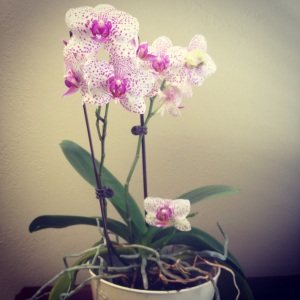I get a lot of questions from friends about how to care for plants. The questions about outdoor plants are all over the map (Q: how long will it take my new blueberry bush to produce? A: about 3 years; Q: why did my basil plant turn black? A: it froze; Q: the best thing for my lawn would be to set it on fire and reseed, right? A: Um, wrong.). But the vast majority of questions about indoor plants are about one type: the phalaenopsis orchid. Folks are so worried about what to do with these plants! So today, I would like to dispel some rumors about orchids.
Phalaenopsis orchids (a/k/a moth orchids) are lovely. Their blooms last at least a month. They are widely available at florist shops, grocery stores, and big box stores—especially around Valentine’s Day and Mother’s Day. Phalaenopsis orchids make a wonderful gift, and that gift could last for years (my oldest phalaenopsis is at least ten years old).
Most folks think that orchids are fussy and hard to grow. I too had been led to believe that orchids must be coddled with special light, special fertilizer, and constant care. Hogwash! I have had excellent results without spritzing “just so” or even remembering to fertilize on a regular basis. In fact, all of my phalaenopsis orchids are currently blooming. Do they look exactly like the ones that were carefully raised in a fancy commercial greenhouse? Mercy, no. But they do have flowers, and I think they’re glorious. See?
Here are the major steps I followed. Disclaimer: my “techniques” have not been approved by any extension services or orchid societies. Obviously.
- I put them near a window. Phalaenopsis orchids are great because they don’t require a whole lot of light, and they are happy with the temperature in my house (between 65º F and 80º F, depending on the season). Before I had my shop light set-up in the laundry room, I kept my orchids in a bright window, and that worked just fine. Now, they are under the shop lights until they bloom. When an orchid is blooming, I usually put it on display somewhere out of direct light so that the blooms will last longer. If it’s been a while since your orchid bloomed, it might need more light.
- I did not repot them in soil. Your orchid will likely come potted in bark or moss. That is because orchids grow best in soilless mixtures. The experts say to repot orchids every one to three years. Um, okay. My orchids are not on an official schedule. When the roots are spilling out of the containers, I think, “Hey, maybe I should repot that.” If I have the same thought several times and I happen to have some orchid potting mixture handy, then I might repot the orchid. But I do always use an orchid potting mixture and not regular potting soil.
- I did not let them sit in water (most of the time), and I did not forget to water them (most of the time). The experts will tell you to water in the morning, placing the plant in the sink and using tepid water and an elaborate ritual that involves letting the water run through the plants for a minute/letting the plant drain completely/gently wiping excess water off the leaves. If you have time to do that, great. If not, just make sure they do get watered. Let them dry out a little before you water them again—if the pot feels heavy, skip watering. My orchids are all potted in a bark medium in plastic pots. The pots sit in seedling trays. I spray water into their pots using an indoor hose that is connected to the laundry room sink. Occasionally, I accidentally overwater, and water remains in the tray/on the leaves. They lived. And although I know I’m not supposed to let the orchids dry out completely, it has happened. They lived. My orchids are not on a strict watering schedule, but I’d say I typically remember to water them about once a week.
- I occasionally remembered to fertilize them. But really not that often. The experts advise using an orchid fertilizer. Some even recommend special fertilizers based on the season—a high nitrogen fertilizer in the spring, and a high phosphorous fertilizer in the fall. They recommend feeding weakly (about half strength) weekly or feeding monthly. Yep. I haven’t quite gotten there yet. I do know that too much fertilizer is bad, so I don’t feel terrible about forgetting to fertilize the orchids. I bought some orchid “bloom booster” fertilizer several years ago, and when I happen to see it sitting on the shelf and happen to have a gallon jug free, I might mix up a batch and feed the orchids. It might happen once a quarter.
- I did not expect miracles. Phalaenopsis orchids bloom once a year. That’s it. So I knew that I wasn’t going to get more flowers shortly after the old ones faded. Okay, if you know how to prune the stem, you might get a second bloom. I have never had much success with stem pruning, so I just cut the stem off when the flowers have faded and wait until next year’s blooms. When the orchid does bloom, the flowers last for weeks.
Now, as you can see, orchids need not be daunting. They can be beautiful even with imperfect care. But if you are interested in knowing how to grow orchids the “right way,” check out the tips from the American Orchid Society.

